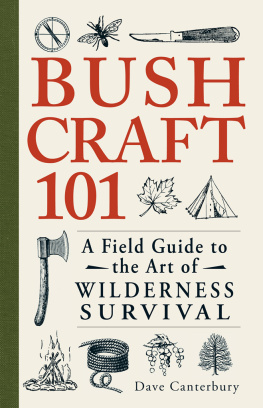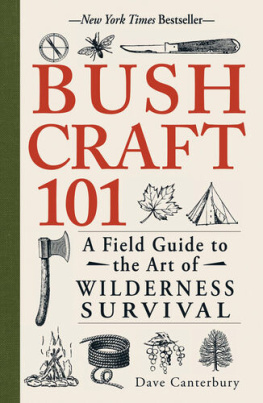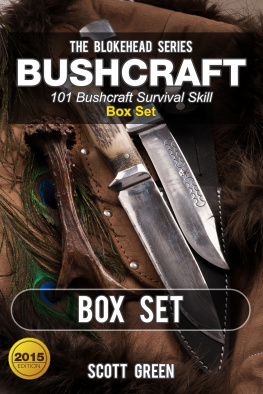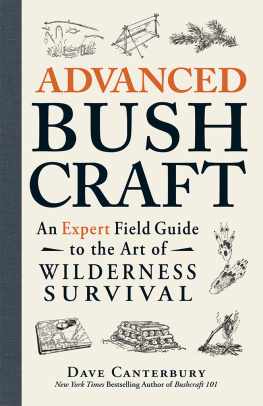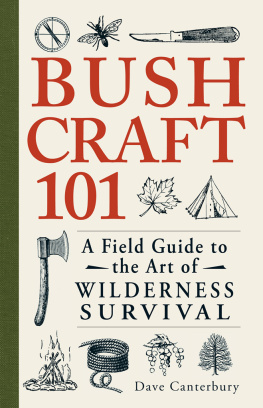BUSH
CRAFT
101
A Field Guide to
the Art of
WILDERNESS SURVIVAL
Dave Canterbury

Avon, Massachusetts
DEDICATION
I would like to dedicate this work to all the frontiersmen and woodsmen who came before me who have passed on their knowledge through their writings and journals. Without these individuals we would not have so much information from which to glean our current knowledge, and without their dedication books like this one would be impossible.
CONTENTS
Introduction
Preconceived notions, especially when one is fairly brought up in their influence, are most difficult to shake off.
STEWART EDWARD WHITE, CAMP AND TRAIL, 1907
Bushcraft is a term for wilderness skills and is the practice of surviving and thriving in the natural world. To effectively practice bushcraft, you must master a unique skill set that includes firecraft, navigation, trapping, creating shelter, tracking, and the use of tools, both modern and primitive. Wise hikers carry few essentials and tools with them on their journeys; instead of extra equipment, they carry the knowledge and skills needed to create necessary items straight from the landscape. To thrive in the woods without the modern comforts available today takes determination. Like any hobby, it requires dedication and knowledge that may in certain circumstances save your life. Many bushcrafting skills are essential to surviving in the wild in an emergency.
Turning to the not-so-distant past, youll find that some of the most influential men in history took life in the wilderness as a serious endeavor as well as a euphoric pastime. They reconnected with nature, conserved resources, and worked to preserve the natural world. Theodore Roosevelt is perhaps the most famous president associated with exploration, preservation, and life in the wild. Working with John Muir, founder of the Sierra Club, he improved the protection of the United States natural wonders, preserving 230 million acres of wildlife habitat across the nation. Within thirty years of the turn of the twentieth century, folks in the United States were rediscovering what it was like to spend time in nature and finding a release from the day-to-day life. Writers and authors such as Horace Kephart and E.H. Kreps captured this new craze by using the terms woodcraft and camping. They followed in the footsteps of their predecessors such as George Washington Sears Nessmuk, who was an innovator in tramping and traveling in the woods for recreationnot survival. More recently, Les Hiddins, the Australian Bush Tucker Man, Mors Kochanski, the Canadian bushcraft and survival instructor, and Ray Mears, the famous English woodsman and instructor, have all brought the practice of bushcraft to contemporary audiences.
Why would anyone, in this era of modern conveniences and incredible technology, leave a comfortable life behind in pursuit of a simpler, but potentially hazardous, tramp in the woods? The reasons are many, and the benefits are numerous. Practicing bushcraft is a great way for you to enjoy the outdoors. If you feel youre trapped in an urban environment, a good tramp is a way to return to the wild, turn off your electronic devices, and escape societys constant pressures. In addition, the abilities you hone in the bush can become lifesaving skills when it comes to disaster preparedness and survival situations.
Nessmuk said it best when he explained, We do not go to the green woods and crystal waters to rough it, we go to smooth it. That is a powerful statement, especially in this day of modern convenience. Many believe that to smooth it, or to be comfortable, means that we need lots of gear and gadgets. In reality, you need very little equipment to succeed in the wild. Instead, you need knowledge of the natural world. This book gives you that knowledge in a short span of words, but it must be complemented by your own experience and time in the bush to gain your own Doctorate in Woodsy Knowledge (a term coined by Mark Baker).
This volume is the perfect companion for outdoor enthusiasts as well as those new to practicing bushcraft. It was written from personal experience, research, and many days and nights afield within several different environments and ecosystems. Guided by my experience, youll discover all youll need for expeditions, from preparing your pack to setting up camp to choosing tools and supplies. This handbook also includes clear instructions on navigating, fire-making, trapping, fishing, foraging, and more. Youll even learn the best ways to conserve resources, both natural and man-made. The tried-and-true instructions, tips, and tricks found here will give you the important bushcrafting skills you need to transition from indoor living to survivingand thrivingin the natural world.
It is my belief that by understanding natural resources and learning about the items that make the difference between comfort and misery, you can attain an almost euphoric experience when spending time on the trail or in the bush. With this book as your guide, soon youll be enjoying the wilderness as wellwithout the need to smooth it. To that end, I present this writing to you, inspired by my heroes and mentors of the past as reclamation and a more contemporary version of bushcraft from my experience in the eastern United States.
Dave Canterbury
PART 1
Gearing Up
Chapter 1
YOUR PACK
The man, who goes afoot, prepared to camp anywhere and in any weather, is the most independent fellow on earth.
HORACE KEPHART, 1904
When you practice bushcraft, you are a self-contained unit: You must carry all you need on your back and on your person, everything necessary to sustain you for the duration of your trip. (You must also include anything you may need in an emergency.)
THE FIVE Cs
You can organize the essentials based on the Five Cs of Survivability. Within these five base elements are all the tools and knowledge you need to be prepared for emergencies as well as to become independent of the trappings of the urban jungle. These items are the hardest to reproduce from natural material, take the largest amount of skill to reproduce, and control the conditions that most directly affect your bodys core temperature. (They can also be used to process raw items to help control your bodys core temperature.) These items, along with your ability to dress for the current conditions and knowledge of the natural world, make it easy to pack a light kit and enjoy your time afoot.
The Five Cs are:
- Cutting tools to manufacture needed items and process food
- Cover elements to create a microclimate of protection from the elements
- Combustion devices for creating the fires needed not only to preserve and cook food, but also to make medicines and provide needed warmth
- Containers to carry water over distances or to protect collected food sources
- Cordages for bindings and lashing
These items, along with knowledge of the landscape and a few items to secure your food, will be the core of what you pack and carry. You can then add a few things for first aid, navigation, and repair to make your life smooth while on the trail and in camp. Does that mean you need a plethora of items that will be miserable to carry or will be so cumbersome as to make you regret the trip within a few hundred yards? No; rather you must choose the right elements for your kit, and you must ensure that these items are of the best quality. In addition, you must make sure that they will perform several needed tasks well.

